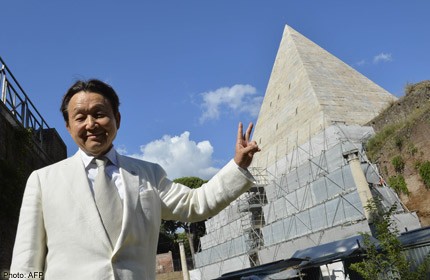Businessman donates $3.3 million to restore Roman pyramid


ROME - A Japanese businessman whose donation helped restore an ancient Roman pyramid said it was a way of thanking Italy for his success, as he toured the monument with Italy's culture minister on Tuesday.
Dressed in an impeccable white suit, the wavy-haired fashion importer Yuzo Yagi admired the work due to be completed within months thanks to his two-million euro (US$2.7 million or S$3.3 million) gift.
"It's an act of gratitude. Our company has grown thanks to Italy," he told AFP at a ceremony on the site - three years after the agreement with Rome authorities was signed.
Asked about the duration, he quipped: "When Italians give a time for finishing, it is never in time. But the first phase is being finished five months ahead of schedule."
Culture Minister Dario Franceschini said he hoped the project would encourage more private donations for restorations -- especially from Italian businesses which can now get major tax breaks.
"This should serve as an example," Franceschini said.
When Yagi was taken to the frescoed funeral chamber inside the pyramid that once housed the remains of the wealthy Roman it was built for, he appeared puzzled.
"Where is the treasure?" he asked restorers, who quickly explained that Roman tradition at the time shunned ostentatious displays of wealth but that a search was underway for a possible hidden second chamber.
"So there was no treasure in Roman pyramids!" he exclaimed.
Outside, he joked with workers cleaning up the pyramid's Carrara marble blocks saying: "Is that really white?"
The 36-metre (118-foot) high pyramid was built in 18-12 BC for Gaius Cestius and stands at the centre of a busy road junction. It was built following Rome's conquest of Egypt, which started off a trend for ancient Egyptian style.
"This is an amazing construction. It has really stood the test of time," said Giuseppina Fazio, a senior restorer, pointing to some World War II bomb and bullet scars visible from scaffolding on the 2,000-year-old monument.